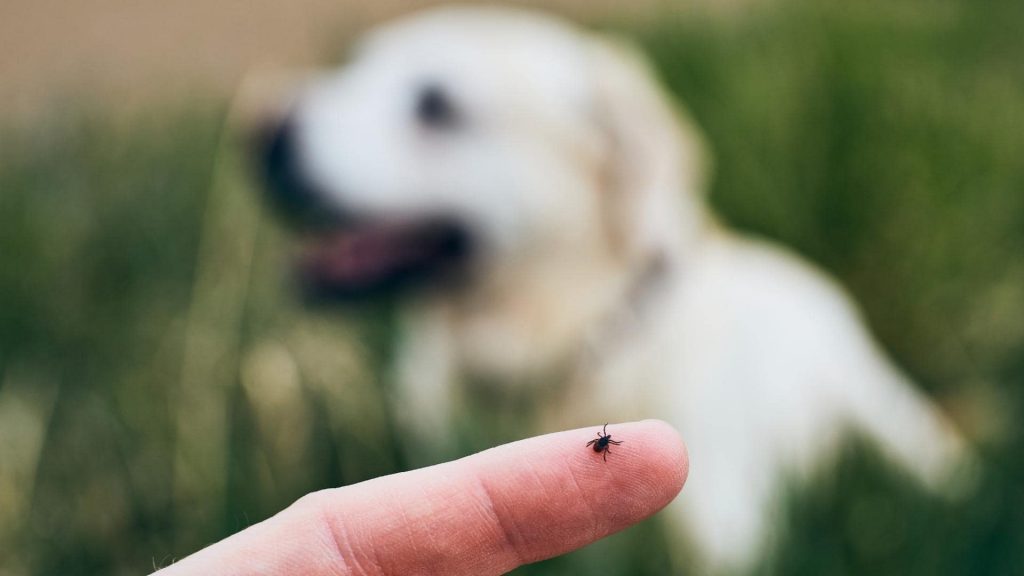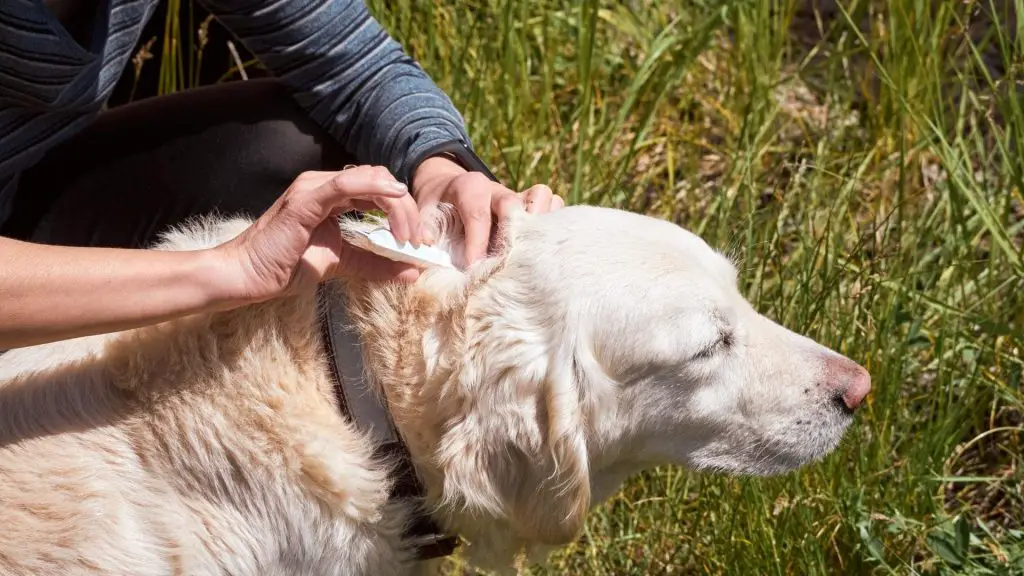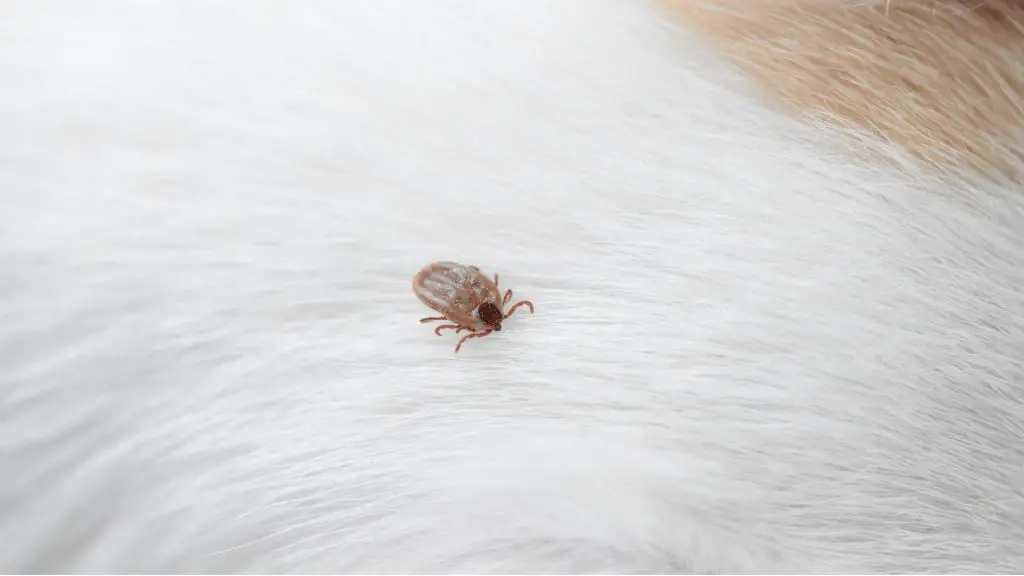Pawscessories is reader-supported. When you buy via links on our site, we may earn an affiliate commission at no cost to you.
Learn more.
If you’ve ever seen a tick on your dog, you know how alarming it can be. Ticks are parasites that feed on the blood of their hosts, and they can become engorged if they feed for a long time.
While most ticks are harmless, some can transmit diseases to dogs. In this post, we’ll discuss why ticks become engorged, whether they’re dangerous to dogs, how to safely remove them, and more!
Let’s jump right in.
Table of Contents

What Is a Tick?
Ticks are small, parasitic insects that feed on the blood of animals. While they are most commonly associated with dogs and other pets, ticks can also be found on humans. Ticks are often found in areas with high grass or bushes and can attach themselves to any exposed skin.
There are more than 850 species of ticks, and they come in a variety of sizes and colors. While most ticks are harmless, some can carry diseases that can cause serious illness or even death.
Lyme disease is the most commonly known illness from a tick bite. But, ticks are also known to transmit a few other diseases like Rocky Mountain spotted fever and ehrlichiosis. Ticks are small, so they’re often hard to spot.
They attach themselves to their host by burrowing their mouthparts into the skin. Ticks feed on blood for several days before falling off. If you find a tick on your body, it’s important to remove it carefully to prevent disease transmission.
To avoid having your dog bitten by a tick, stay away from wooded areas where they’re commonly found. If you live in an area where ticks are prevalent, use insect repellent and do your best to keep your dog out of tall grass.
Checking their body for ticks after spending time outdoors is also important. If you find a tick on your dog, don’t panic.
There are many ways to remove a tick safely and effectively. However, if you have any concerns, it’s always best to consult with a veterinarian.
How Do Ticks Get On Dogs In The First Place?
Many people think that ticks automatically jump on to dogs when they are outside. However, that’s not how ticks usually get on dogs. Instead, ticks typically lie and wait in long grass for an animal – such as a deer, dog, or human – to walk by.
Then, they climb onto the animal and attach themselves to the skin. Once attached, the tick will start to feed on the animal’s blood. This is why it’s important to check your dog for ticks after spending time outdoors and to remove any ticks promptly.
What Are Common Places For Ticks To Be In The Wild?
As previously mentioned, ticks are most commonly found in wooded areas with long grass. They can also be found in gardens and parks.
Are Engorged Ticks Dangerous to Dogs?

While ticks are not always dangerous to dogs, they can transmit a number of serious diseases. The most common being Lyme disease, which can cause joint pain, fever, and even paralysis.
Ticks can also transmit other diseases, including Rocky Mountain spotted fever, anaplasmosis, and ehrlichiosis. In addition, ticks can cause an allergic reaction in some dogs, resulting in redness, swelling, and itching.
If a tick has any of these diseases, the longer they’re attached to a dog, the more likely it will pass the disease on. So if you notice a tick is engorged on your dog, it means they’ve been attached for a few days or so.
Which, if the tick has a disease, increases the chances that they’ve passed it on to your dog.
While there are a number of tick-borne diseases that can affect dogs, there are also several steps that owners can take to protect their pets. These steps include using tick preventatives, checking for ticks regularly, and promptly removing any ticks that are found.
Why Do Ticks Become Engorged?
When a tick latches onto a host, it doesn’t just drink its fill of blood and then detach. Instead, the tick continues to feed until it’s completely engorged, which can take several days.
This might seem like an odd strategy, but there are actually several important reasons why ticks become engorged. First of all, engorged ticks are much less likely to be dislodged from their host.
This increases the chances that they’ll be able to mate and lay eggs. Additionally, an engorged tick can survive for months without food, giving it plenty of time to find another suitable host.
Problems and Diseases Caused By Engorged Ticks on Dogs
While it’s certainly not pleasant to find an engorged tick on your dog, it’s important to remember that not all ticks carry disease. In fact, the vast majority of ticks are harmless.
However, many serious diseases can be transmitted by ticks, so it’s important to be aware of the potential risks. Lyme disease, ehrlichiosis, anaplasmosis, and Rocky Mountain spotted fever are all serious diseases that can be transmitted by ticks.
Lyme disease is the most common disease to come from a tick bite in the United States. It can cause a wide range of symptoms in dogs, including lameness, fever, and loss of appetite.
Rocky Mountain spotted fever is another severe disease that can come from a tick bite and can cause a high fever, joint pain, and vomiting in dogs. The condition can lead to organ damage and even death if left untreated.
While RMSF is rare in the United States, it is important to be aware of the symptoms and to seek medical treatment if your dog shows any signs of illness. Early diagnosis and treatment are essential for a successful outcome. With prompt medical care, most dogs recover from Rocky Mountain spotted fever without any lasting effects.
Anaplasmosis is a bacterial disease that can cause fever, lethargy, and diarrhea in dogs. If left untreated, the disease can lead to anemia, kidney failure, and even death. Fortunately, anaplasmosis is treatable with antibiotics. However, it is important to catch the disease early.
Ehrlichiosis is another bacterial disease that is transmitted by ticks. The disease can cause a wide range of symptoms, including fever, lethargy, weight loss, and bleeding disorders. Ehrlichiosis is a serious disease that can be fatal if left untreated. However, it is also treatable with antibiotics.
Tick preventives are an important part of protecting your dog from tick-borne diseases. There are a variety of products available, and if you’re unsure which to use, your veterinarian can help you choose the best option for your dog.
How Do Engorged Ticks Give Dogs a Disease?
As we just looked at, ticks can transmit a variety of diseases to dogs. These diseases are caused by bacteria that are present in the tick’s saliva.
When the tick feeds on a dog, the bacteria are injected into the dog’s bloodstream. The bacteria then multiply and cause the dog to develop the disease.
Where Are Engorged Ticks Usually Found On Dogs?

Ticks are most often found on dogs’ heads, necks, and ears. However, they can attach themselves to any part of the dog’s body.
It’s important to check these areas on your dog regularly for ticks, especially if they spend time in wooded areas or tall grass.
How To Find Engorged Ticks on Dogs?
The best way to find engorged ticks on your dog is to conduct a thorough tick check after each walk or time spent outside.
To do this, you’ll need to carefully examine your dog’s fur, paying close attention to their head, neck, and ears. If you find a tick, it’s important to remove it as soon as possible.
How Do You Get Rid Of An Engorged Tick On a Dog?

There are a few different ways to remove an engorged tick from your dog. The most important thing is to be careful and avoid crushing the tick’s body. This can cause the bacteria in its saliva to be released into your dog’s bloodstream.
One way to remove an engorged tick is to use a pair of fine-tipped tweezers. Gently grab the tick as close to the dog’s skin as possible and pull straight up. Avoid twisting or jerking when removing the tick, as this can cause its mouth to separate from its body and remain in your dog’s skin.
Another way to remove an engorged tick is to use a commercial tick removal tool. These tools are designed to remove ticks without crushing their body.
Once the tick has been removed, it’s important to dispose of it properly. The best way to do this is to place it in a jar or plastic bag and put it in the freezer. This will kill the tick and prevent it from biting anyone else.
You should also clean the area where the tick was attached with rubbing alcohol or antiseptic wipes.
How To Tell How Long a Tick Has Been On a Dog?
It can be difficult to tell how long a tick has been on your dog. However, removing the tick as soon as possible is important, as the longer it’s attached, the greater the risk of disease transmission.
One way to tell how long a tick has been on your dog is to look at its body. An engorged tick will have a large, round body that is filled with blood. A tick that has been attached for less time will have a smaller body that is not as engorged.
Another way to tell how long a tick has been on your dog is to look at the area around the bite. If the area is red and inflamed, this is a sign that the tick has been attached for a while.
Regardless of how long the tick has been attached, it’s important to remove it as soon as possible.
Will An Engorged Ticks Fall Off By Themselves?
Yes, an engorged tick will eventually fall off by itself. However, this can take days or even weeks. During this time, the tick will continue to feed on your dog’s blood and can transmit diseases.
It’s much safer to remove the tick yourself than to wait for it to fall off. This way, you can be sure that the tick is removed correctly and that your dog is not at risk for any diseases.
How to Prevent Your Dog From Getting Ticks?
The best way to prevent your dog from getting ticks is to use a tick prevention product. There are many different products available, including collars, spot-on treatments, and shampoos.
Choosing a product specifically designed for dogs is important, as some products (such as insecticides) can be toxic to them. It’s also important to follow the instructions carefully and apply the product as directed.
Another way to prevent your dog from getting ticks is to avoid areas where they are commonly found. This includes wooded areas, tall grass, and bushes. If you live in an area where ticks are common, having your dog wear a tick collar or other protective clothing is also a good idea.
Finally, you should always check your dog for ticks after they’ve been outside. This is especially important if they’ve been in an area where ticks are known to be present.
By taking these precautions, you can help to keep your dog safe from ticks and the diseases they can carry.
FAQs

What does it mean if a tick is engorged?
An engorged tick is a tick that is full of blood. This happens when the tick has been attached to a host for a period of time and has been able to feed on their blood. Engorged ticks can be dangerous because they can transmit diseases to their host.
How long will an engorged tick stay on a dog?
An engorged tick will eventually fall off by itself, but this can take days or even weeks. During this time, the tick can continue to feed on your dog’s blood and transmit diseases. Therefore, removing the tick yourself is much safer than waiting for it to fall off.
Should I remove an engorged tick from my dog?
Yes, you should remove an engorged tick from your dog as soon as possible. The longer the tick is attached, the higher likelihood of disease transmission. You can remove the tick yourself or take your dog to the vet to have it removed.
What happens if tick head stays in dog?
If the tick head stays in your dog, it will eventually fall out on its own. However, this can take days or even weeks. During this time, the tick head can become infected and cause problems for your dog.
This is why it’s important to be careful when removing a tick from your dog and to ensure that the entire tick is removed. If you’re not confident in your ability to do it properly, it’s best to take your dog to the vet.
Should I take my dog to the vet for a tick?
If you’re not comfortable removing the tick yourself or if your dog is showing any signs of illness, it’s always best to take them to the vet. They can safely remove the tick and help treat any diseases passed on to your dog.
Final Thoughts
Ticks can be dangerous to both humans and animals. If you find an engorged tick on your dog, removing it as soon as possible is important. This will help to prevent the transmission of any diseases.
Always be sure to follow the instructions carefully when using any tick prevention products, and check your dog regularly for ticks. If you have any concerns or aren’t comfortable removing it yourself, it’s never a bad idea to take them to the vet.
Other posts you might find interesting:
Dried Dead Tick On Dog? What You Need To Do (Vet Answers)
